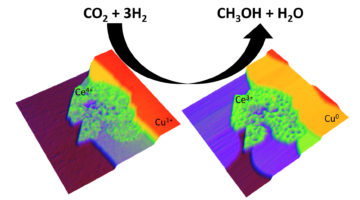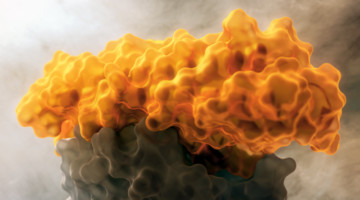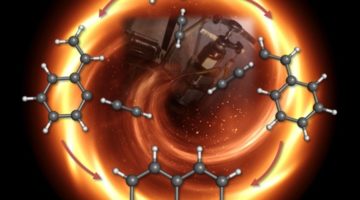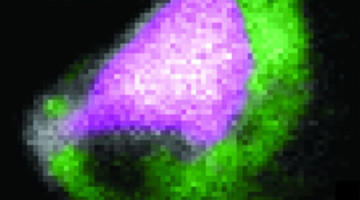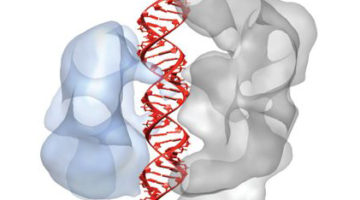Researchers have found novel nanocatalysts that lower the barrier to converting carbon dioxide—an abundant greenhouse gas—into methanol—a key commodity used to produce numerous industrial chemicals and fuels. In one case, it worked almost 90 times faster than catalysts commonly used for this reaction today. Read more »![]()
![]()
Science Highlights
Designer Proteins Target Epstein-Barr-Virus-Associated Cancer
Researchers used new protein design approaches to develop a potential inhibitor of Epstein-Barr-Virus-associated cancer. The study shows not just how to help defeat the virus, but also opens up a whole new way to design proteins against viruses and ultimately, cancer. Read more »![]()
![]()
ALS Evidence Confirms Combustion Theory
Researchers recently uncovered the first step in the process that transforms gas-phase molecules into solid particles like soot and other carbon-based compounds. It’s a discovery that could help combustion chemists make more efficient, less polluting fuels and help materials scientists fine-tune their carbon nanotubes and graphene sheets for faster, smaller electronics. Read more »![]()
![]()
An Iridate with Fermi Arcs
Researchers have discovered that “Fermi arcs,” much-debated features found in the electronic structure of high-temperature superconducting (HTSC) cuprates, can also be found in an iridate (iridium oxide) compound—strontium iridate. Read more »![]()
![]()
Skyrmion Behavior Revealed by Two X-Ray Studies
Two research groups have recently published separate studies in which soft x-rays reveal how skyrmions—quasiparticles made up of spin vortices—react to external fields. Their work lays the foundation for understanding these fascinating constructs and eventually utilizing them in spintronic applications. Read more »![]()
![]()
Space Dust Analysis Could Provide Clues to Solar System Origins
New studies of space dust captured by NASA’s Stardust Interstellar Dust Collector have shown that interstellar particles may be much more complex in structure and composition than previously thought. Read more »![]()
![]()
Infrared Mapping Helps Optimize Catalytic Reactions
A pathway to more effective and efficient synthesis of pharmaceuticals and other flow-reactor chemical products has been opened by a study in which, for the first time, the catalytic reactivity inside a microreactor was mapped in high resolution from start to finish. Read more »![]()
![]()
Validating Computer-Designed Proteins for Vaccines
Computationally designed proteins that accurately mimic key viral structures can help produce better vaccines. The resulting protein structures, validated at the ALS, encourage the further development of this strategy for a variety of vaccine targets, including HIV and influenza. Read more »![]()
![]()
Iron is the Key to Preserving Dinosaur Soft Tissue
Researchers studying organic material from dinosaur bones have been able to show that the samples contained original soft tissue material from Mesozoic dinosaurs. The x-ray techniques at the ALS were key to showing a possible mechanism for this unexpected preservation.
Read more »![]()
![]()
Intriguing DNA Editor Has a Structural Trigger
The molecular structures of two proteins from a family of genome-editing enzymes reveal how they target and cleave DNA. The results point the way to the rational design of new and improved versions of the enzymes for basic research and genetic engineering. Read more »![]()
![]()
- « Previous Page
- 1
- …
- 22
- 23
- 24
- 25
- 26
- 27
- Next Page »
